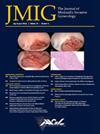A Comparative Study on the Efficacy of Subendometrial Versus Intrauterine Platelet-Rich Plasma Injections for Treating Intrauterine Adhesions: A Retrospective Cohort Study
IF 3.5
2区 医学
Q1 OBSTETRICS & GYNECOLOGY
引用次数: 0
Abstract
Objective
Comparison of the clinical efficacy of hysteroscopic subendometrial injection of platelet-rich plasma (PRP) and intrauterine instillation of PRP for the treatment of intrauterine adhesions.
Design
A Retrospective Cohort Study.
Setting
University hospital.
Patients
Patients who underwent hysteroscopic transcervical excision of adhesions from September 1, 2020, to July 31, 2023, and were treated with PRP in the postoperative period were included.
Interventions
Subendometrial PRP injection group (referred to as SE-PRP group) and intrauterine PRP infusion group (referred to as IU-PRP group)
Measures and main results
A total of 299 patients with moderate-to-severe IUA treated with PRP after Transcervical resection of adhesions (TCRA) were included. The primary outcome metric was the clinical pregnancy rate, and the secondary outcome metrics were the rate of menstrual improvement and the AFS score. The results showed that: the AFS reduction scores was greater in the SE-PRP group than in the IU-PRP group (8 vs 7, p = 0.019); the menstrual improvement rate in the SE-PRP group was higher than that in the IU-PRP group (77.0% vs 52.9%, p < 0.001); and the clinical pregnancy rate in the SE-PRP group was similar than that in the clinical pregnancy rate in the IU-PRP group (28.4% vs 20.4%, p = 0.208). The results of multifactorial logistic regression analysis showed that the clinical pregnancy rate in the SE-PRP group was significantly higher than that in the IU-PRP group (OR = 2.020, 95% CI = 1.050–3.889, p = 0.035). The results of the propensity score matching (PSM) analysis showed that: the median postoperative AFS score reduction was significantly higher in the SE-PRP group than in the IU-PRP group (p = 0.015); and the rate of improvement in menstruation was significantly higher in the matched SE-PRP group (75.0% vs 58.1%, p = 0.027) and clinical pregnancy rates were higher in the SE-PRP group (29.4% vs 16.2%, p = 0.043).
Conclusions
Hysteroscopic intrauterine PRP injection is more clinically effective than intrauterine PRP infusion for patients with moderate to severe intrauterine adhesions, resulting in greater reduction in adhesion scores, improvement in menstrual rate, and increased clinical pregnancy rate.
子宫内膜下与宫内富血小板血浆注射治疗宫内粘连的疗效比较:一项回顾性队列研究。
目的:比较宫腔镜子宫内膜下注射富血小板血浆(PRP)与宫内灌注PRP治疗宫内粘连的临床疗效。设计:回顾性队列研究。单位:大学医院。患者:纳入2020年9月1日至2023年7月31日行宫腔镜经宫颈粘连切除术,术后行PRP治疗的患者。干预措施:子宫内膜下PRP注射组(简称SE-PRP组)和宫内PRP输注组(简称u -PRP组)措施及主要结果:共纳入299例经宫颈粘连切除术(TCRA)后PRP治疗的中重度IUA患者。主要结局指标是临床妊娠率,次要结局指标是月经改善率和AFS评分。结果显示:SE-PRP组AFS降低评分高于IU-PRP组(8比7,P = 0.019);SE-PRP组月经改好率高于IU-PRP组(77.0% vs 52.9%, P < 0.001);SE-PRP组临床妊娠率与IU-PRP组相似(28.4% vs. 20.4%, P = 0.208)。多因素logistic回归分析结果显示,SE-PRP组临床妊娠率显著高于IU-PRP组(OR = 2.020,95% CI = 1.050-3.889,P = 0.035)。倾向评分匹配(PSM)分析结果显示:SE-PRP组术后AFS评分中位数降低明显高于IU-PRP组(P = 0.015);SE-PRP组月经改善率显著高于对照组(75.0% vs. 58.1%, P = 0.027),临床妊娠率显著高于对照组(29.4% vs. 16.2%, P = 0.043)。结论:宫腔镜下宫腔内PRP注射对中重度宫腔内粘连患者的临床疗效优于宫腔内PRP输注,可显著降低粘连评分,改善月经率,提高临床妊娠率。
本文章由计算机程序翻译,如有差异,请以英文原文为准。
求助全文
约1分钟内获得全文
求助全文
来源期刊
CiteScore
5.00
自引率
7.30%
发文量
272
审稿时长
37 days
期刊介绍:
The Journal of Minimally Invasive Gynecology, formerly titled The Journal of the American Association of Gynecologic Laparoscopists, is an international clinical forum for the exchange and dissemination of ideas, findings and techniques relevant to gynecologic endoscopy and other minimally invasive procedures. The Journal, which presents research, clinical opinions and case reports from the brightest minds in gynecologic surgery, is an authoritative source informing practicing physicians of the latest, cutting-edge developments occurring in this emerging field.

 求助内容:
求助内容: 应助结果提醒方式:
应助结果提醒方式:


